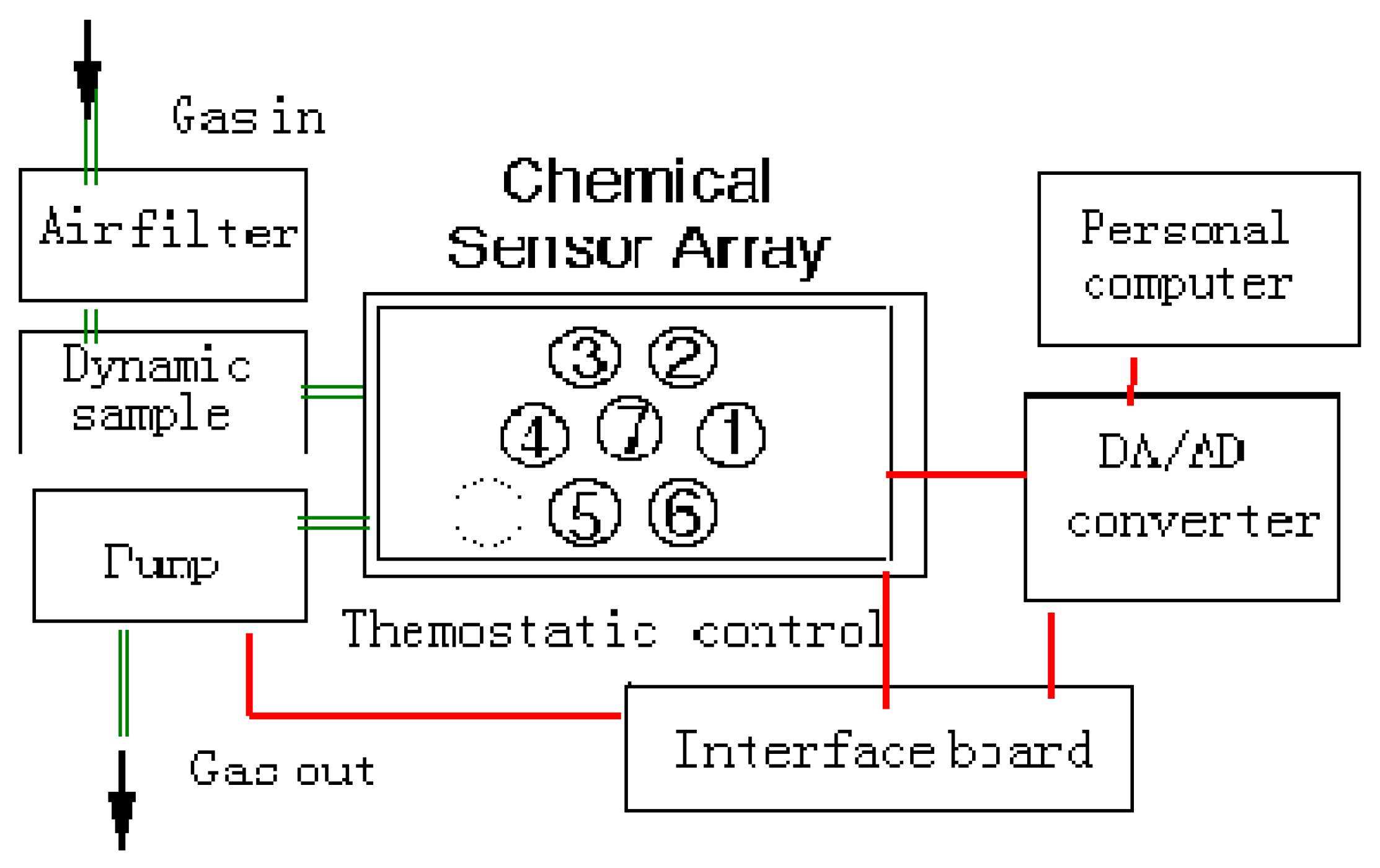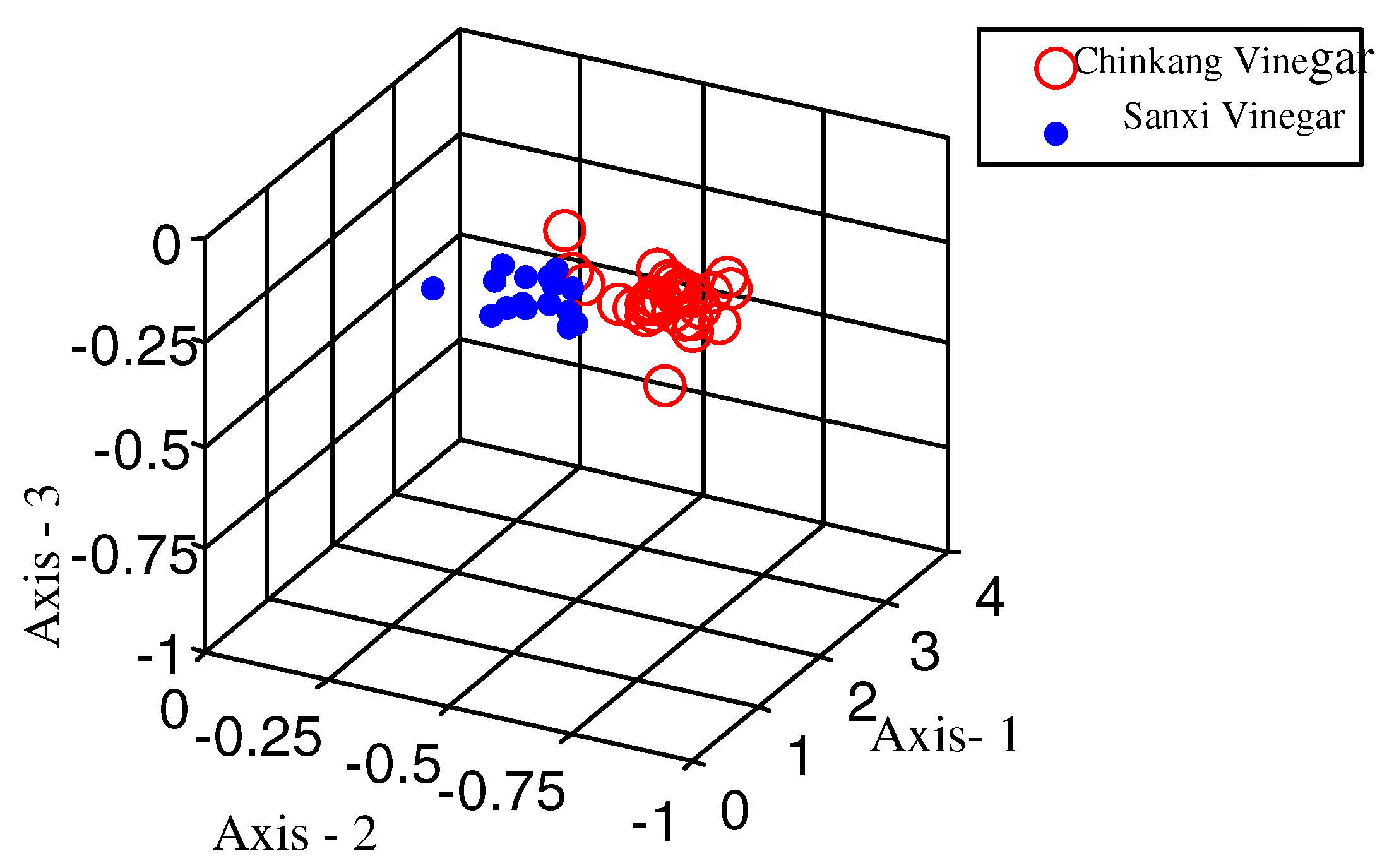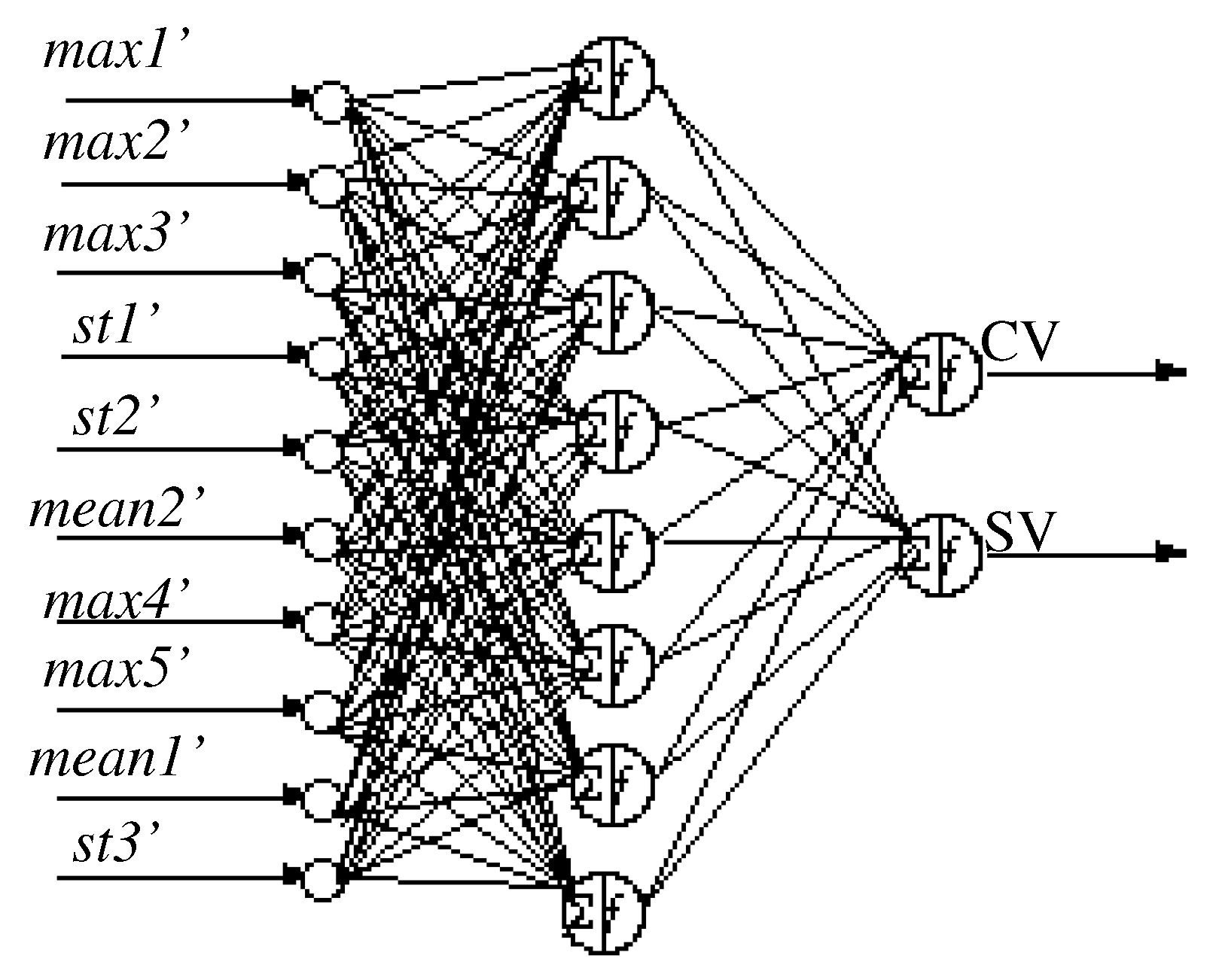Vinegar Classification Based on Feature Extraction and Selection From Tin Oxide Gas Sensor Array Data
Abstract
:Introduction
Experiments


Feature Extraction and Selection

| Extracted feature | Represent meaning |
| Max slope (kmax) | The respond rate of sensor to different vinegar gas |
| Maximum (max) | The maximum respond value |
| Average of last 20 points (st) | The stationary phase of equilibrium between reversible adsorption and desorption |
| Average of whole points (mean) | Sensor respond value during the whole process |
Performance Criteria

Results and Discussion
| Feature parameter | TGS813 | TGS880 | ||||||
| Max 1 | St1 | Mean 1 | Kmax 1 | Max | St2 | Mean 2 | Kmax 2 | |
| D□I□ | 1.53 1 | 1.416 | 1.217 | 0.791 | 1.501 | 1.384 | 1.373 | 0.816 |
| D□R□ | 91.8 | 88.5 | 85.0 | 75.1 | 91.5 | 88.1 | 87.5 | 77.3 |
| Feature parameter | TGS822 | TGS825 | ||||||
| Max | St | Mean | Kmax | Max | St | Mean | Kmax | |
| D□I□ | 1.42 4 | 1.158 | 0.976 | 0.074 | 1.352 | 0.930 | 0.859 | 0.002 |
| D□R□ | 89.3 | 84.9 | 83.7 | 54.6 | 86.9 | 82.6 | 80.5 | 50.5 |
| Feature parameter | TGS812 | |||||||
| Max | St | Mean | Kmax | |||||
| D□I□ | 1.32 1 | 1.110 | 0.622 | 0.005 | ||||
| D□R□ | 86.1 | 84.5 | 73.2 | 52.0 | ||||

| Type: | Backpropagation in batch mode |
|---|---|
| Architecture: | 10-8-2 feedforward |
| Activation: | Logistic |
| Learning Rate: | 0.01 |
| Momentum: | 0.2 |
| No. of Epochs: | 15000 |

Conclusions
Acknowledgements
References
- Gardner, J.W.; Bartelet, P.N. Electronic nose: Principles and Applications; Oxford University Press, 1999; Volume 1-4, pp. 185–207. [Google Scholar]
- Christophe, S.; et al. Potential of semiconductor sensor arrays for the origin Authentication of pure valencia orange Juices. Journal of Agricultural & Food Chemistry 2001, 49, 3151–3160. [Google Scholar]
- Giuseppe, Z.; et al. Determination of organic acids, sugars, diacetyl, and action in cheese by high performance liquid chromatographic. Journal of Agricultural & Food Chemistry 2001, 49, 2722–2726. [Google Scholar]
- Vernat-Rossi, V.; Garcia, C.; Talon, R.; et al. Rapid discrimination of meat products and bacterial strains using semi-conductor gas sensors. Sensors and Actuators B 1996, 37, 43–48. [Google Scholar] [CrossRef]
- Natale, C.D.; Davide, F.A.; Amico, M.A.; et al. An electronic nose for the recognition of the vineyard of a red wine. Sensors and Actuators B 1996, 33, 83–88. [Google Scholar] [CrossRef]
- Nanto, H.; Tsubakino, S.; Ikeda, M.; et al. Identification of aromas from wine using quartz-resonator gas sensors in conju-ction with neural-network analysis. Sensors and Actuators B 1995, 24-25, 794–796. [Google Scholar] [CrossRef]
- Funazaki, N.; Hemmi, A.; Ito, S.; et al. Application of semiconductor gas sensor to quality control of meat freshness in food industry. Sensors and Actuators B 1995, 24-25, 797–800. [Google Scholar] [CrossRef]
- Natale, C.D.; Davide, F.A.; Amico, M.A.D.; et al. Complex chemical pattern recognition with sensory array. The discrimination of vintage years of wine. Sensors and Actuators B 1995, 24-25, 801–804. [Google Scholar] [CrossRef]
- Singh, S.; Hines, E.L.; Gardner, J.W.; et al. Fuzzy neural computing of coffee and tainted-water from an electronic nose. Sensors and Actuators B 1996, 30, 185–190. [Google Scholar] [CrossRef]
- Bourrounet, B.; Talou, T.; Gaset, A. Application of a multi-gas-sensor device in the meat industry for boar-taint detection. Sensors and Actuators B 1995, 26-27, 250–254. [Google Scholar] [CrossRef]
- Molto, E.; Selfa, E. An Aroma Sensor for Assessing Peach Quality. Journal of Engineering Research 1999, 72, 311–316. [Google Scholar] [CrossRef]
- Gardner, J.W.; Bartlett, N. A brief history of electronic nose. Sensors and Actuators B 1994, 18-19, 211–220. [Google Scholar] [CrossRef]
- Huyberechts, G. Simultaneous quantification of carbon monoxide and methane in humid air using a sensor array and an artificial neural networks. Sensors and Actuators B 1997, 45, 123–130. [Google Scholar] [CrossRef]
- Weiping, Y.; Chengfen, D.; et al. The study of gas sensor array signal processing with improved BP algorithm. Sensors and Actuators B 2000, 66, 283–285. [Google Scholar]
- Holmberg, M.; Gustafsson, F.; et al. Bacteria classification based on feature extraction from sensor data. Biotechnology Techniques 1998, 4, 319–324. [Google Scholar] [CrossRef]
- Zou, X.B.; Zhao, J.W. The study of sensor array signal processing with new genetic algorithms. Sensors and Actuators B 2002, 87, 437–441. [Google Scholar]
- Zou, X.B.; Wu, S. Evaluating the quality of cigarettes by an electronic nose system. Journal of Testing and Evaluation 2002, 30(12), 6. [Google Scholar]
- Zou, X.B. Study of electronic nose on simulation inspecting the process of ferment in the brewage of vinegar (in Chinese). Master’s degree thesis, Jiangsu University, Zhenjiang, Jiangsu , China, 2001; p. 3. [Google Scholar]
- Laurent, R.; Tekin, K.; Thomas, M. etc. A comparative study of signal processing technique for clustering microsensor data (a first step towards an artificial nose). Sensors and Actuators B 1997, 41, 105–120. [Google Scholar]
- Wang, P. Artificial nose and Artificial tongue (in Chinese). Science book concern. Beijing, China. 2000; 12. [Google Scholar]
- Sample Availability: Available from the authors.
© 2003 by MDPI (http://www.mdpi.net). Reproduction is permitted for noncommercial purposes.
Share and Cite
Xiaobo, Z.; Jiewen, Z.; Shouyi, W.; Xingyi, H. Vinegar Classification Based on Feature Extraction and Selection From Tin Oxide Gas Sensor Array Data. Sensors 2003, 3, 101-109. https://doi.org/10.3390/s30400101
Xiaobo Z, Jiewen Z, Shouyi W, Xingyi H. Vinegar Classification Based on Feature Extraction and Selection From Tin Oxide Gas Sensor Array Data. Sensors. 2003; 3(4):101-109. https://doi.org/10.3390/s30400101
Chicago/Turabian StyleXiaobo, Zou, Zhao Jiewen, Wu Shouyi, and Huang Xingyi. 2003. "Vinegar Classification Based on Feature Extraction and Selection From Tin Oxide Gas Sensor Array Data" Sensors 3, no. 4: 101-109. https://doi.org/10.3390/s30400101
APA StyleXiaobo, Z., Jiewen, Z., Shouyi, W., & Xingyi, H. (2003). Vinegar Classification Based on Feature Extraction and Selection From Tin Oxide Gas Sensor Array Data. Sensors, 3(4), 101-109. https://doi.org/10.3390/s30400101




